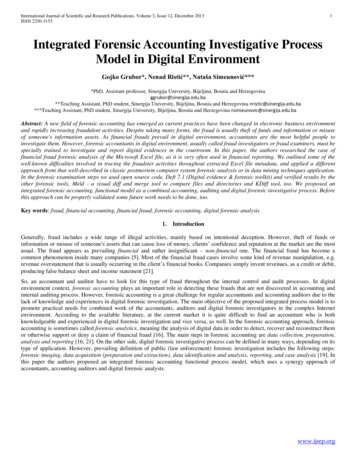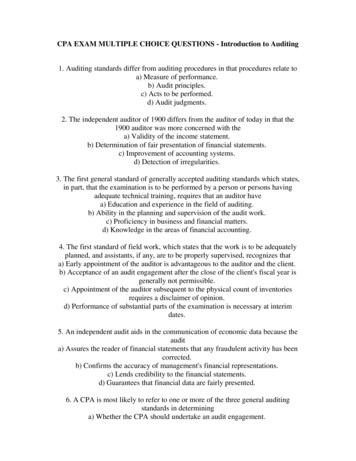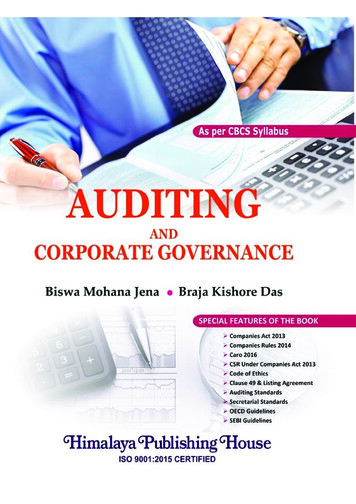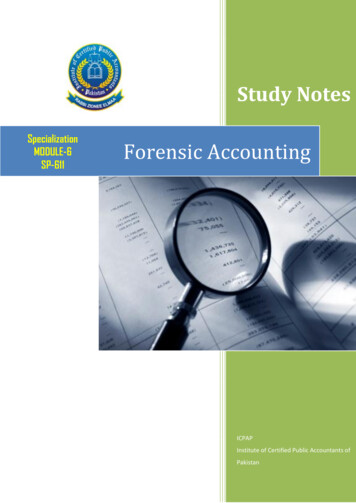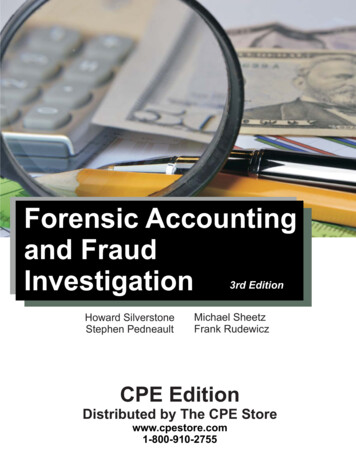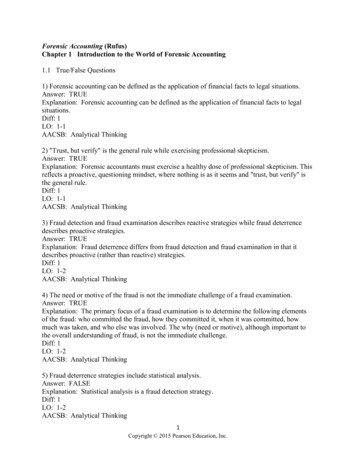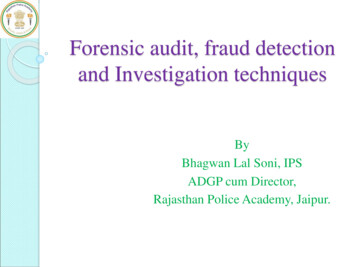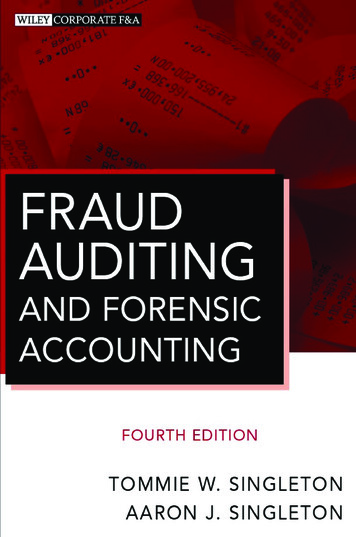
Transcription
FFIRS07/01/201013:20:1Page 2
FFIRS07/01/201013:20:1Page 1Fraud Auditing andForensic Accounting
FFIRS07/01/201013:20:1Page 2
FFIRS07/01/201013:20:1Page 3Fraud Auditing andForensic AccountingFourth EditionTOMMIE W. SINGLETONAARON J. SINGLETONJohn Wiley & Sons, Inc.
FFIRS07/01/201013:20:1Page 4Copyright # 2010 by John Wiley & Sons, Inc. All rights reserved.Published by John Wiley & Sons, Inc., Hoboken, New Jersey.Published simultaneously in Canada.No part of this publication may be reproduced, stored in a retrieval system, ortransmitted in any form or by any means, electronic, mechanical, photocopying,recording, scanning, or otherwise, except as permitted under Section 107 or 108 of the1976 United States Copyright Act, without either the prior written permission of thePublisher, or authorization through payment of the appropriate per-copy fee to theCopyright Clearance Center, Inc., 222 Rosewood Drive, Danvers, MA 01923, (978)750-8400, fax (978) 646-8600, or on the Web at www.copyright.com. Requests tothe Publisher for permission should be addressed to the Permissions Department, JohnWiley & Sons, Inc., 111 River Street, Hoboken, NJ 07030, (201) 748-6011,fax (201) 748-6008, or online at http://www.wiley.com/go/permissions.Limit of Liability/Disclaimer of Warranty: While the publisher and author have usedtheir best efforts in preparing this book, they make no representations or warranties withrespect to the accuracy or completeness of the contents of this book and specificallydisclaim any implied warranties of merchantability or fitness for a particular purpose. Nowarranty may be created or extended by sales representatives or written sales materials.The advice and strategies contained herein may not be suitable for your situation. Youshould consult with a professional where appropriate. Neither the publisher nor authorshall be liable for any loss of profit or any other commercial damages, including but notlimited to special, incidental, consequential, or other damages.For general information on our other products and services or for technical support,please contact our Customer Care Department within the United States at(800) 762-2974, outside the United States at (317) 572-3993 or fax (317) 572-4002.Wiley also publishes its books in a variety of electronic formats. Some content thatappears in print may not be available in electronic books. For more information aboutWiley products, visit our web site at www.wiley.com.Library of Congress Cataloging-in-Publication Data:Singleton, Tommie.Fraud auditing and forensic accounting/Tommie W. Singleton, Aaron J. Singleton. –4th ed.p. cm.Rev. ed. of: Fraud auditing and forensic accounting. 3rd ed. 2006.Includes index.ISBN 978-0-470-56413-4; ISBN 978-0-470-87748-7 (ebk);ISBN 978-0-470-87790-6 (ebk); ISBN 978-0-470-87791-3 (ebk)1. White collar crime investigation–United States. 2. Forensic accounting–UnitedStates. 3. Fraud investigation–United States. I. Singleton, Aaron J., 1980II. Fraud auditing and forensic accounting. III. Title.HV8079.W47B65 2010364.1603—dc222010013504Printed in the United States of America10 9 8 7 6 5 4 3 2 1
FFIRS07/01/201013:20:1Page 2
FTOC07/01/201022:7:32Page 5ContentsPrefacexiAcknowledgmentsxiiiChapter 1: Background of Fraud Auditing andForensic AccountingIntroductionBrief History of Fraud and the Antifraud ProfessionThe Fraud CycleReview of Technical LiteratureForensic Accountant and AuditsForensic AccountantsFraud AuditorsKeys to Effective Fraud InvestigationThe Antifraud Professional’s CareerSummaryNotesChapter 2: Fraud PrinciplesIntroductionDefinition: What Is Fraud?Synonyms: Fraud, Theft, and EmbezzlementClassic Fraud ResearchFraud TriangleScope of FraudProfile of FraudstersWho Is Victimized by Fraud Most Often?Fraud TaxonomiesFraud TreeEvolution of a Typical 49535462656869v
FTOC07/01/2010vi22:7:32nPage 6ContentsChapter 3: Fraud SchemesIntroductionACFE Fraud TreeFinancial Statement SchemesCorruption SchemesAsset Misappropriation SchemesSummaryNotesChapter 4: Red FlagsIntroductionProfessional StandardsCommon Red FlagsSpecific Red FlagsFraud Detection ModelSummaryNotesChapter 5: Fraud Risk AssessmentIntroductionTechnical Literature and Risk AssessmentRisk Assessment FactorsRisk Assessment Best PracticesRisk Management Checklists and DocumentationSummaryNotesChapter 6: Fraud PreventionIntroductionPrevention EnvironmentPerception of DetectionClassic ApproachesOther Prevention MeasuresAccounting 43143
FTOC07/01/201022:7:32Page 7ContentsChapter 7: Fraud DetectionIntroductionFraud Detection AxiomsCommon Detection MethodsSpecific Detection MethodsSummaryAppendix 7A: Beneish’s RatiosChapter 8: Fraud ResponseIntroductionFraud PolicyFraud Response TeamRecoverySummaryNotesAppendix 8A: ACFE Sample Fraud PolicyAppendix 8B: Sample Fraud Policy Decision MatrixChapter 9: Computer CrimeIntroductionHistory and Evolution of Computer CrimesComputer Crime Theories and CategorizationsCharacteristics of the Computer EnvironmentInformation Security (INFOSEC)Profiling Internet FraudstersSummaryNotesChapter 10: Fraud and the Accounting Information SystemIntroductionAccounting ConceptsSegregation of DutiesAccounting Information SystemsKey PersonnelComputer HardwareComputer SoftwareNew Forms of MediaAudit Trail 96202203204208210211211212
FTOC07/01/2010viii22:7:32nPage 8ContentsChapter 11: Gathering Evidence213IntroductionRules of EvidenceHearsay ExceptionsOther Rules of EvidenceSummaryNotes213213217218223223Chapter 12: Cyber Forensics225IntroductionExpectation of PrivacyTypes of InvestigationsSources of Digital DataTypes of Cyber DataCyber Forensics Investigation ProcessVariety of Specialists in Cyber ForensicsSummaryNotesChapter 13: Obtaining and Evaluating NonfinancialEvidence in a Fraud ExaminationIntroductionInterviewsBody LanguageDeception CuesEye LanguageStatement 7239239240242243244245246247247Chapter 14: General Criteria and Standards forEstablishing an Expert Witness’s Qualifications249IntroductionCredentialsPersonal Qualities of the ExpertSources for Locating Expert WitnessesDistinguishing the Actual Area of CompetenceSummaryNotes249250255259261261262
FTOC07/01/201022:7:32Page 9ContentsnChapter 15: The Legal Role and Qualifications ofan Expert WitnessIntroductionRole of a Forensic Accountant as a Witness in CourtLegal Qualifications for a Forensic Accountant as an Expert WitnessQualification and Admissibility of Accounting EvidenceExpert’s Role in the Litigation TeamPretestimony ActivitiesSummaryNotesAppendix 15A: Transcript of Typical Court Testimonyof Expert WitnessChapter 16: Effective Tactics and Procedures for theExpert Witness in CourtIntroductionEffective ProfileBeing a Credible Expert WitnessExpert’s Role in the Litigation TeamPretestimony ActivitiesTrial and TestimonySurvival TechniquesSummaryNotesChapter 17: Fraud and the Public Accounting ProfessionIntroductionHistory of Fraud and the Auditor: A SummaryFraud and the Auditor’s LiabilityFraud and the Auditor’s ResponsibilityFraud and the Auditor’s RoleSummaryNoteAbout the 8308
FTOC07/01/201022:7:32Page 10
FPREF07/01/201017:23:50Page 11PrefaceWhen times are good, people steal. When times arebad, people steal more!TH I S Q U O T E W A S M A D E casually in a conversation by Tommie to anacademic colleague, but does represent the raison d’ etre for the newedition of this book. Since time immortal, there have always been anumber of humans who are bent in their ethics, morals, sociological makeup,psychological makeup, or sense of justice, and are ready, willing, and able tocommit crimes of all types, including white-collar crimes. But hard economictimes seem to cause a few more than normal to crumble under the economicpressure and give in to the temptation to commit a fraud.The Association of Certified Fraud Examiners (ACFE) did an empirical studyin 2009 on the effect of the weak economy on the number of frauds beingdetected by CFEs, entitled ‘‘Occupational Fraud: A Study of the Impact of anEconomic Recession.’’ Based on the results of the responses of 507 CFEs, morethan half indicated that the number of frauds had increased since the recessionbegan (37.3 percent slight increase, 18.1 percent significant increase). About49 percent also saw an increase in the dollar amount of the losses due to fraud.Obviously, and empirically evident in the ACFE study, pressure has increasedon an increasing number of people due to the recession. And as all antifraudprofessionals know, pressure is a key to the occurrence of frauds. Therefore,there is a greater need than ever for corporations, companies, and governmentagencies to be vigilant to protect assets that are more precious than ever.We are proud to be a part of the fourth edition of this book. The book beginswith a general background about fraud auditing and forensic accounting inxi
FPREF07/01/2010xii17:23:50nPage 12PrefaceChapter 1. Chapters 2 through 5 provide the basics of fraud such as fraudschemes, how they are perpetrated, what red flags (similar to fingerprints) existfor certain types of schemes, understanding the fraudster, and a fraud riskassessment to identify weak areas. Chapters 6 through 8 follow the ‘‘PDC’’model for the antifraud profession: prevent, detect, and correct (respond).Chapters 9 though 12 cover the information technology (IT) aspects of fraudincluding the computer as an instrument of fraud, the target of fraud, and thefact systems are ‘‘data warehouses’’ that contain evidence of fraud. Chapter 13focuses on the nonfinancial aspects of fraud investigation. Chapters 14 through16 focus on the legal disposition of a fraud investigation and the major legalconcepts, principles, and help for fraud auditors and forensic accountants,especially related to evidence and expert testimony. Chapter 17 is writtenspecifically for public accounting and CPAs.The material has been slightly reorganized from the third edition to makereading and assimilation of the content easier. New material includes updatesin fraud response (a new Chapter 8), computer-related fraud (Chapter 9), cyberforensics (Chapter 12), physiological aspects of the fraudster (a new Chapter13), and fraud and the CPA (Chapter 17).We hope this book enables and empowers auditors, CPAs, law enforcement, risk and loss prevention professionals, and all others who have aresponsibility related to fraud to better prevent, detect, and respond to fraud.Tommie W. SingletonAaron J. SingletonAugust 2010
FLAST07/01/201018:7:19Page 13AcknowledgmentsIT IS T R U E T H A T anything or anyone visible to the public eye is actuallystanding on the shoulders of others who made that moment possible. So wewould like to acknowledge a few ‘‘shoulders.’’First, we want to thank Jack Bologna and Robert Lindquist, authors of thefirst two editions of this book. In 1992, Dr. Tommie Singleton interviewed JackBologna as part of his dissertation at the University of Mississippi on the topic ofpioneers in electronic data processing (EDP) audit. Mr. Bologna was indeed apioneer not only in EDP audit, but also in forensic accounting. Jack wasinvolved with the Association of Certified Fraud Examiners (ACFE) in its earlydays, was editor for what may have been the first forensic accounting journal inthe 1980s, and was an academic who taught forensic accounting. Hiscontributions are a monument and testimony to his knowledge and abilitiesregarding fraud. Robert Lindquist has a strong reputation of being a fraudexpert and is sought after as an expert witness in fraud cases. His work andefforts are stellar, and he is a well-respected professional in Canada and theUnited States.Second, we would like to thank some individuals who have helped us inour professional growth. Former FBI agent Alton Sizemore became a supporterand friend to Dr. Singleton about 14 years ago. He is a frequent guest lecturer inTommie’s classes, even when he was over 100 miles from the university whereDr. Singleton taught for many of those years. He has taught us much regardingthe legal elements of fraud, digital evidence, and the law enforcement perspective of fraud. He also has taught us to have fun when circumstances allow it.Indeed, Alton is a favorite of former students for these reasons.Kevin Andrews has been a supporter, continually involving us in the localchapter of the ACFE. Like Alton, Kevin is a staple in Dr. Singleton’s classesspeaking to students about the antifraud profession and how to develop acareer as a forensic accountant. He also had a vision of a local, high quality,xiii
FLAST07/01/2010xiv18:7:19nPage 14Acknowledgmentsfraud seminar for Birmingham which he made happen two years ago, and ofwhich we are pleased to be a part.Another great friend is Ralph Summerford of Forensic/Strategic Solutionsin Birmingham, Alabama. He became a supporter of Dr. Singleton instantly attheir first meeting, and has been a faithful, instrumental supporter over the lasteight years. No one has been more inspiring or financially supportive of Dr.Singleton’s academic programs than Mr. Summerford.Another person who has been instrumental in teaching, supporting, andmodeling the antifraud profession to us is retired U.S. Treasury investigatorLynn Shobe. Lynn is a key leader in our area, especially for the local ACFEchapter. But he also is an adjunct professor for the forensic accountingprogram at UAB where Dr. Singleton is the director of that program and anassociate professor.Third, we want to extend a special thank you to Sheck Cho, Wiley editor.He has been a wonderful supporter of our efforts not only on two editions of thisbook, but on another book as well. Stacey Rivera, our development editor onthis edition, was professional throughout, patient and kind, and a joy to workwith.
C0106/30/201011:17:5Page 11CHAPTER ONEBackground of FraudAuditing and ForensicAccountingThere’s a sucker born every minute.—P. T. BarnumTrust everyone, but cut the deck.—P. T. BarnumINTRODUCTIONIn the first decade of the twenty-first century, the news has been filled withreports on frauds and indicators that it is increasing in its scope and coststo the U.S. economy. Almost everyone has read about corporate financialstatement frauds such as Enron and WorldCom, or frauds against the government such as false claims following Katrina, or huge Ponzi schemes such asthe Madoff scam that set a new record for losses associated with a fraud.1
C0106/30/2010211:17:6nPage 2Background of Fraud Auditing and Forensic AccountingMany people have been directly affected by identity theft. The economicdownturn that began in 2008 has made it hard to rebound from suchlosses. To make matters worse, reports on activities related to fraud bearbad news.A 2007 report from the Federal Bureau of Investigation (FBI) estimatesthat fraud in non-health insurance costs more than 40 billion per year,or put another way, costs the average U.S. family between 400 and 700per year in increased premiums!1 In the same report, the FBI estimates thatcosts associated with fraudulent claims following the Katrina hurricanedisaster accounted for as much as 6 billion. The FBI also reports thatsuspicious activity reports (SAR) filed by banks increased 36 percent for2008 over 2007. Of the SARs filed in 2007, 7 percent indicated a specificdollar loss, which totaled more than 813 million.2 The FBI was investigating over 1 billion in mortgage frauds in 2008.3 All these facts existedbefore the economic meltdown and scrutiny brought to the subprime mortgage industry.The Internet Crime Complaint Center (IC3) is a federal watchdog agencyformed as a partnership of the National White Collar Crime Center (NW3C) andthe FBI that serves as a center to receive, process, and refer criminal complaints regarding the rapidly expanding area of cybercrime. Its 2008 AnnualReport shows a 33 percent increase in complaint submissions over 2007, whichis the trend over this decade. The total losses from 2008 complaints were 265 million with a median loss of 931,000 per complaint.4The National Insurance Crime Bureau (NICB) says that 10 percent of allproperty or casualty insurance claims, 15 percent of auto theft claims, and20 percent of workers’ compensation claims involve some form of fraud.According to the NICB, auto insurance theft costs 20 to 30 billion a year.The NICB reports that questionable claims reports in the first half of 2009 hasincreased 13 percent over first half of 2008 and the numbers in nearly allreferral categories are rising as well.The Association of Certified Fraud Examiners (ACFE) provides periodicsurveys of fraud and reports the results to the public in its Report to the Nation(RTTN). Results were published in 1996, 2002, 2004, 2006, and 2008. The1996 RTTN reported an estimate of over 400 billion in losses due to fraud,which increased over the years to an estimated 994 billion in 2008. Fraudclearly continues to cost organizations and society huge sums of money, bothrecently and throughout the history of commercial business.
C0106/30/201011:17:6Page 3Brief History of Fraud and the Antifraud Professionn3BRIEF HISTORY OF FRAUD AND THEANTIFRAUD PROFESSION 5According to some, forensic accounting is one of the oldest professions anddates back to the Egyptians. The ‘‘eyes and ears’’ of the king was a person whobasically served as a forensic accountant for Pharaoh, watchful over inventories of grain, gold, and other assets. The person had to be trustworthy,responsible, and able to handle a position of influence.In the United States, fraud began at least as early as the Pilgrims and earlysettlers. Since early America was largely agricultural, many frauds centeredaround land schemes. Perhaps the most infamous colonial era land scheme wasthe purchase of Manhattan Island (what is now Brooklyn), bought from theCanarsie Indians. The land was bought for trinkets worth about 24. In thiscase, the Native Americans tricked the white man, as the Canarsie Indians soldland not even connected to Manhattan Island, and Manhattan Island wasinhabited by Manhattan Indians, to whom the Dutch had to pay a second timefor the land. Land swindles grew as America expanded west.The advent of business organizations created new opportunities for fraud.The earliest corporations were formed in seventeenth-century Europe. Nationschartered new corporations and gave them public missions in exchange for alegal right to exist, separation of ownership from management, and limitedliability that protected shareholders from losses of the business entity. One suchcorporation, the Massachusetts Bay Company, was chartered by Charles I in1628 and had a mission of colonizing the New World.The first major corporate fraud is probably the fraud known as the SouthSea Bubble. The South Sea Company was formed in 1711 with exclusivetrading rights to Spanish South America. The company made its first tradingvoyage in 1717 and made little actual profit to offset the 10 million ofgovernment bonds it had assumed. South Sea then had to borrow 2 millionmore. Tension between England and Spain led to the capture of South Sea shipsby Spain in 1718. In 1719, the company proposed a scheme by which it wouldtake on the entire remaining national debt in Britain, over 30 million, using itsown stock at 5 percent in exchange for government bonds lasting until 1727.Although the Bank of England offered also to assume the debt, Parliamentapproved the assumption of the debt by the South Sea Company. Its stock rosefrom 128 in January 1720 to 550 by the end of May that year, in aspeculation frenzy.
C0106/30/2010411:17:6nPage 4Background of Fraud Auditing and Forensic AccountingThe company drove the price of the stock up through artificial means;largely taking the form of new subscriptions combined with the circulation ofpro-trade-with-Spain stories designed to give the impression that the stockcould only go higher. Not only did capital stay in England, but many Dutchinvestors bought South Sea stock, thus increasing the inflationary pressure.6Other joint-stock companies then joined the market, usually makingfraudulent claims about foreign ventures, and were nicknamed ‘‘bubbles.’’In June 1720, the Bubble Act was passed, which required all joint-stockcompanies to have a royal charter. Partly because it had a royal charter,the South Sea Company shares rocketed to 890 in early June 1720. Theprice finally reached 1,000 in early August, and a sell-off that began inJune began to accelerate. The sell-off was begun largely by directors themselves cashing in on huge stock profits. As the stock price began to decline,the company directors attempted to talk up and prop up the stock (e.g.,having agents buy stock) but to no avail—the stockholders had lost confidence and a run started in September. By the end of the month, the stockprice dropped to a low of 150.With investors outraged, and as many of them were aristocrats, Parliament was recalled in December and an investigation began. As part of thatinvestigation, an external auditor, Charles Snell, was hired to examine thebooks of the South Sea Company. This hiring was the first time in the history ofaccounting that an outside auditor was brought in to audit books, and marksthe beginning of Chartered Accountants in England and thus the beginning ofCertified Public Accountants (CPAs) and financial audits as we know themtoday. Thus CPAs owe their profession, at least to a large extent, to a fraud.In 1721, Snell submitted his report. He uncovered widespread corruptionand fraud among the directors in particular and among company officialsand their friends at Westminster. Unfortunately, some of the key players hadalready fled the country with the incriminating records in their possession.Those who remained were examined and some estates were confiscated.At about the same time, France was experiencing an almost identical fraudfrom a corporation originally known as the Mississippi Company that hadexclusive trading rights to North America in the French-owned MississippiRiver area. Using similar tactics of exaggerating the potential profits, thecompany owner, famous economist John Law, was able to cause a frenziedupward spiral of its stock prices, only to see it collapse after the Regent ofOrleans dismissed him in 1720. The company sought bankruptcy protectionin 1721. Like South Sea, it was a fraud perpetrated by the exaggerations ofexecutive management.
C0106/30/201011:17:6Page 5Brief History of Fraud and the Antifraud Professionn5In 1817, the Meyer v. Sefton case involved a bankrupt estate. Since thenature of the evidence was such it could not be examined in court, the judgeallowed the expert witness who had examined the bankrupt’s accounts totestify to his examination. Forensic accounting professor and author Dr. LarryCrumbley considers this accountant to be the first forensic accountant inhistory and the beginning of forensic accounting as a profession.In 1920, Charles Ponzi planned to arbitrage postal coupons, buying themfrom Spain and selling them to the U.S. Postal Service, using foreign exchangerates as leverage to make a profit. In order to raise capital for the scheme, hepromised outlandish returns to investors—50 percent in 90 days. Ponzi paidthe first returns with the cash proceeds from those coming in later, thenhe personally took the proceeds from later entrants to the scheme. He wasimprisoned for defrauding 40,000 people of 15 million. To this day, that typeof scheme is referred to as a Ponzi scheme.In the 1920s, Samuel Insull was involved in a fraud scheme similarto the railroad and South Sea Bubble schemes, but it occurred in the electricutility business. Insull sold millions of dollars of common stock in electricutility companies to unwary investors. The stock was greatly overpricedin terms of the utilities’ real assets. When the stock market collapsed in 1929,it was apparent that Insull’s holding company was insolvent and had been forsome time.Some researchers, such as Dr. Dale Flesher and Dr. Tonya Flesher, havepresented sound arguments that the Securities Act of 1933 and the SecuritiesExchange Act of 1934 are a direct result of the Ivar Kreuger (‘‘Match king’’)fraud rather than the stock market crash of 1929. Kreuger & Toll, amultibillion-dollar conglomerate, was a huge fraud built on shell companiesand unaudited financial statements. Kreuger & Toll securities were among themost widely held in the United States. When the company went under in1932, after Kreuger had committed suicide, investors lost millions in thelargest bankruptcy of its time. Therefore, the argument goes, the existence ofthese legislative acts requiring financial audits of all companies with listedsecurities and the Securities and Exchange Commission (SEC) is the result ofa major financial fraud, and can be seen by comparing the tenets of the actsagainst the financial fraud perpetrated by Kreuger versus the stock marketcrash itself. The acts of 1933 and 1934 essentially created the demand forfinancial auditors and the CPA profession that exists to this day.A major savings and loan scandal hit hard in the early 1980s, precedingthe energy and telecommunication companies’ frauds in the 1990s. Thelatter led the seeming explosion of fraud around the last half of the 1990s
C0106/30/2010611:17:6nPage 6Background of Fraud Auditing and Forensic Accountingand the early 2000s. During this period, high-dollar frauds reached all typesof industries. For example, Waste Management in trash services, Phar-morin pharmacy, Sunbeam in manufacturing, Enron in energy, WorldCom intelecommunications, Adelphia in media, Fannie Mae in government, andHealthSouth in health services all occurred during this time. Several of thesefrauds were among the largest ever, and they occurred during a short periodof time.Although the cost of the WorldCom fraud was far greater, the most notablefraud, as far as impact on the business community, is probably Enron. In 2001,Enron filed bankruptcy after disclosing major discrepancies in revenues andliabilities in its financial reports. The audit firm Arthur Andersen came to anend as a result of the ramifications of the Enron scandal by 2002. In 2002, theU.S. Congress passed the Sarbanes-Oxley Act (SOX) due to that fraud andothers, such as WorldCom. Perhaps nothing has brought more attention tofraud audits and forensic accounting than the Enron scandal and SOX.More recently, the housing and real estate boom of the 2000s has led toincreased fraud particularly in the area of mortgage fraud. While the impact ofthese frauds is not yet entirely clear, mortgage fraud losses for 2007 alone havebeen estimated to be at least 800 million. SARs from financial institutionsindicated an increase in mortgage fraud reporting. SARs increased 31 percentto 46,717 during fiscal year (FY) 2007. The total dollar loss attributed tomortgage fraud is unknown. However, 7 percent of SARs filed during FY 2007indicated a specific dollar loss, which totaled more than 813 million.7 Variouspieces of legislation have been passed in response, continuing the cycle ofevolving frauds and attempts to control them.Are all of these events merely historical flukes? Did media attentioncreate them? Perhaps. Media attention may have created the original publicawareness, but the frauds and corruption were there all the time, and thereexists no real way of measuring or comparing them. Part of the problemduring the period of time when such large frauds occurred was the mind-setof the regulators and auditors, which has since turned around completely.Claims by management and others are less likely to be accepted at face value,and the financial well-being of the general public is more of a concern toantifraud and audit professions. Suspicion fell on industries, professions, andvarious areas of government. The undivided attention of auditors, regulators,management, and employees then led to wholesale charges of fraud, theft,and corruption.The fraud environment can be and often is viewed as a pendulum,swinging from one extreme to the other with little time in between at the
C0106/30/201011:17:6Page 7The Fraud Cyclen7proper balancing point. After 2002, the pendulum was close to an extremeend, one that entailed ultraconservatism on the part of companies, andauditors as well, and the stiffest requirements and enforcement by regulatorsand legislators. After swinging toward a more balanced position, the recenteconomic crisis has moved the pendulum back toward the extreme of 2002.This cycle (pendulum swing) is a natural result of human nature,business cycles, and the nature of legislation and regulation. The cyclecan certainly be influenced and controlled to some extent, but it will probablynever cease.Fraud auditing literature discloses a common theme: Fraud is endemic andpervasive in certain industries, locales, companies, and occupations at particular points in history. For example, railroad promoters in the 1870s raisedmore capital from less informed investors than ever before and the railroadindustry had numerous frauds exposed. During the 1950s, more doctorswere involved in more income tax frauds than ever before or since. Foodfranchisers, in the late 1960s, are another example of the fraud phenomenon.Some fast-food franchisers sold unwary small investors on untested restaurantconcepts at overvalued prices. These half-baked concepts led to the bankruptcyof many of the franchisees. During the Watergate era of the early l970s,politicians were involved in corruption and fraud against taxpayers, andcorporations were involved in political and commercial
Forensic Accounting 1 Introduction 1 Brief History of Fraud and the Antifraud Profession 3 The Fraud Cycle 7 Review of Technical Literature 9 Forensic Accountant and Audits 11 Forensic Accountants 20 Fraud Auditors 25 Keys to Effective Fraud Investigation 31 The Antifraud Professional’s Career 33 Summary 36 Notes 37 Chapter 2: Fraud Principles 39File Size: 2MB
